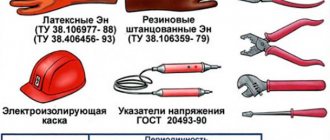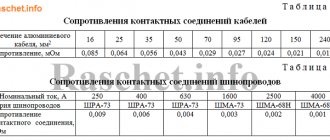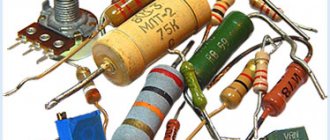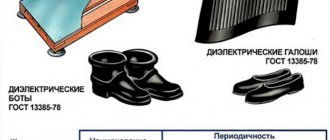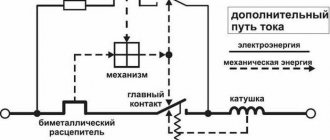Working with electricity is a dangerous process and requires compliance with certain safety rules. All equipment must be de-energized and grounded, and the worker must use only specialized insulated tools and dielectric gloves, which completely eliminate the slightest chance of electric shock.
The main purpose of dielectric gloves is to protect human hands from electric shock when working with equipment and networks with voltages above 1000V. Special materials prevent a person from injuring the skin of his hands and fingers when repairing and installing equipment and wiring.
Types and features of special-purpose gloves
The range of dielectric gloves is not very extensive. The main materials for the manufacture of workwear are thick sheet rubber and latex. The sizes of the products are shaped in such a way that the worker can wear warm mittens under them during the cold season. The gloves have a standard length of 35 cm and are worn over the sleeves of clothing in order to eliminate the slightest chance of electrical sparks hitting a person.
Hand protection when working with electrical equipment and networks is divided into several categories:
- Two- and five-fingered. The latter type of gloves is more convenient, as it allows you to fully use the entire hand, simplifying the process of repairing electrical equipment and installing wiring.
- Seamless and with seam. Dielectric suture gloves (drilled) are made of dense rubber and the presence of a seam is provided for in the design. However, such products are quite comfortable and lightweight.
- For work with electrical networks up to 1000V (designation Ev) and over 1000V (marking En).
What to pay attention to
Each pair is individually packaged, hermetically sealed, with sufficiently durable material for storage. On the outside of the package, the factory data, model features, class, cat., size are written down. Inside there are instructions with the following minimum information: how to store, use, dispose of, periodically inspect and test, GOST.
Service life and features of use
Dielectric gloves are manufactured in accordance with the requirements of GOST 13385-78. According to this standard, the shelf life of these products at temperatures from -30C to +40C is 1 year, without taking into account their use of gloves or storage in a warehouse. Moreover, the shelf life is valid only if the storage conditions are met - air humidity not higher than 75%, no direct sunlight, no contact with oils, gasoline and other chemicals. At the end of the shelf life from the date of issue, dielectric gloves are written off in the manner prescribed by each organization.
During storage in a fold, as well as during operation, the frequency of testing of dielectric gloves must be observed - procedures that allow you to determine the suitability of protective products. For dielectric gloves, the inspection period is once every 6 months, regardless of the type of product and its material.
What shortcomings should be absent?
Inside and outside, any damage, defects revealed during tests, inspections - holes, bubbles, conductive non-rubber inclusions, folds, pinches, bulges created during use - are not allowed, except for the exceptions below.
Features due to the very shape of the model or production are acceptable, for example, marks left during formation similar to a cut, but in reality this is how the edge is positioned. The following are also considered within normal limits:
- depressions, convex segments, areas extruded by shapes - if they disappear when stretched;
- inclusions - if they remain in the same place when bending or stretching;
- inclusions of paint - up to 1 mm from the inside on the working segment.
The working surface is the space between the fingers and the fingers themselves, the palm. The surface of the last two segments can be made in such a way (thickening, corrugation, etc.) to enhance the holding qualities; this is not a flaw.
Requirements for gloves for electricians
Mittens for electricians are essential protective equipment, so they must meet certain parameters. Among the main requirements for dielectric gloves are:
- High quality workmanship - gloves should not contain residual traces of production, protruding rubber fibers, or defective seals.
- The standardized dimensions of the mittens must be observed, in particular, a length of at least 35 cm.
- The gloves must be stamped with the last inspection performed in accordance with the established frequency.
- Marking designation Ev or Vn to determine the maximum voltage for which personal protective equipment for electricians is designed.
- Absence of mechanical damage, contamination, moisture or cracks - these requirements are specified in GOST for dielectric gloves.
What must be endured
A certificate of compliance with GOST is mandatory and must be provided by the supplier. The document means that the product has been tested and can withstand the electrical, mechanical, climatic and other influence categories corresponding to its class.
After use in cold conditions in the ranges corresponding to those in which the tests were carried out, there should be no cracks, holes, etc.
Additional requirements for composite products:
Testing dielectric gloves: procedure and features
To check the performance characteristics for compliance with the requirements of the standard, dielectric gloves must undergo a testing procedure. They are carried out both at the manufacturing plant and directly at the place of storage and operation in accordance with the frequency of tests of dielectric gloves prescribed in GOST.
To test dielectric gloves in the laboratory, a special stand is used - a bath with water and an electrical installation. The glove is placed in a bath and filled with water, while a current of a certain frequency and strength is supplied between the body of the container and the electrode inside. If a breakdown is detected, the glove is rejected, and the data is entered into the dielectric gloves test form indicating all the data.
Among the main advantages of this method of checking gloves for electricians are:
- High accuracy due to use for testing electronic equipment.
- The presence of a regulator that allows you to increase the voltage and current during testing so that the experimental environment corresponds to real operating conditions.
Dielectric gloves are checked once every 6 months - twice during the entire service life of the products. After a successful test, when the gloves for electricians meet the stated requirements of the standard, a stamp must be affixed to them - it must be clearly readable and not wear out over time. This mark shows how often dielectric gloves have been tested, as well as their safety for further use and the expiration date.
After any test of dielectric gloves, a protocol form is also filled out - it indicates the timing of the next checks, the main characteristics of the protective equipment and other data. With such documents, gloves are delivered directly to the place of use or stored in warehouses.
How to choose correctly
Working with dielectric gloves should, first of all, be comfortable and safe. Therefore, such an accessory must also be selected correctly. Dielectric gloves produced by modern industry can have a variety of sizes. For example, a consumer can easily purchase dielectric seamless gloves “PER” 001 size 2 to 1 KV in Moscow, St. Petersburg, Chelyabinsk or any others.
The length of such protective equipment, according to regulations, cannot be less than 35 cm. In any case, such products are usually chosen taking into account the fact that warm gloves or mittens will be worn over them. It is believed that protective equipment of this type should completely fit the palm, but at the same time sit quite loosely. The width of dielectric gloves is selected in such a way that they subsequently fit easily onto the sleeves.
When purchasing gloves, among other things, you should look at the technical data sheet that comes with them. This document specifies all the parameters and characteristics of the product. For various work related to electricity, in enterprises, at home and in public utilities, gloves designed for this specific case should be used.
Checking for punctures and cracks: inspection rules
The beginning of any electrical work using dielectric gloves is necessarily associated with a thorough inspection of the protective equipment for punctures, cracks and other mechanical damage. The presence of even the smallest defect is unacceptable, because in this case the mittens lose their protective insulating properties and can transmit electric current, and this creates a danger for the worker.
Inspection of dielectric gloves for mechanical damage also has a certain frequency. It is performed during regular tests and before starting work. It is easy to identify cracks and breaks on the surface of products - to do this, you need to twist them towards your fingers or fill them with water - many defects will immediately become visible. Additionally, an inspection is carried out for the presence of moisture and contamination.
Rules of application
Before starting work, therefore, the gloves must be inspected and checked for integrity. You should also definitely pay attention to the last date of their testing and expiration date. Unfortunately, gloves that are too old can become brittle and dry. Accordingly, when carrying out work using them, an electrician may receive an electric shock.
Gloves must be worn to their full depth. At the same time, their edge should protrude above the sleeves of the overalls.
One of the important rules for using dielectric gloves is that they cannot be cleaned with gasoline, alkalis or acids. For this purpose, it is allowed to use, as already mentioned, only soda and soap.
Dielectric gloves should be stored at temperatures from 0 to 25 °C. Of course, you should not keep such products near open fire or heated objects, including heating radiators.
In some cases, dielectric gloves, like any other product, of course, have to be transported. When transporting such protective equipment from one climate zone to another, their use is immediately prohibited. Delivered gloves should first be kept indoors at room temperature for 24 hours.
Storage rules and protection from deformation and damage
The rules for using dielectric gloves require compliance with certain storage rules. In particular, to maintain their performance characteristics, protective products should be thoroughly cleaned of dirt immediately after work - for this, soap and water are used, as well as special disinfectants that are harmless to rubber and latex. After cleaning, the mittens must be dried.
When storing, dielectric gloves and boots must be protected from direct sunlight and avoid contact with oils, acids, and gasoline. In the room where protective equipment is stored, a certain temperature regime must be observed - from -30C to +40C - there is no high humidity or dust.
Dielectric gloves are a universal and reliable means of protection when performing electrical work. The use of dense rubber and latex makes it possible to ensure a long service life of the products, but it can be extended even further if you do not wrinkle the protective equipment during work, put them on correctly and do not use them openly in installations where there are sharp edges. For example, leather mittens can be worn over gloves.
What does the marking tell you?
Rice. 5
When purchasing electrically insulating gloves, you need to pay attention not only to the passport data of the product, but also to the markings applied directly to the product. This information contains:
- A special sign (two triangles) indicating operation under voltage.
- Exact product name, article number, product code.
- GOST or TU according to which the product is made.
- Class of dielectric gloves.
- Description of protective properties, category.
- Product size.
- Production date, service life.
The labeling indicates the manufacturer and the sign of the product's circulation on the market. There is also information about care and disposal rules.
